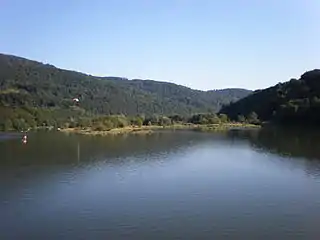Solahütte
Solahütte (a.k.a. Solehütte, Soletal, SS-Hütte Soletal, or SS Hütte Porabka)[1] was a little-known resort in Poland for the Nazi German guards, administrators, and auxiliary personnel of the Auschwitz/Birkenau/Buna facilities during the Holocaust in occupied Poland. Although postcards of the era sent by German staff sometimes bore the mysterious pre-printed return address "SS Hütte Soletal", the rustic hamlet remained largely unknown to historians until 2007, when the Höcker Album of memorabilia owned by SS officer Karl-Friedrich Höcker including vintage Auschwitz photographs was donated to the United States Holocaust Memorial Museum, which then released images from the album online for study. Some of the photographs identified Solahütte for the first time.[2][3]
| Solahütte | |
|---|---|
.jpg.webp) General view of the Solahütte guest-house of the Nazi German personnel and administration of the Auschwitz concentration camp complex during the Holocaust in occupied Poland. Photograph from the Höcker Album | |
 Lake Międzybrodzkie on the Soła river at the foot of Międzybrodzie Bialskie village, located 30 kilometres (19 mi) south of Auschwitz; about half-an-hour drive along Road DW 948 |
Solahütte is around 29 kilometres (18 miles) by car from Auschwitz. The site is located near the bends in the Soła river where in 1935 engineers finished a heavy dam which created the scenic Międzybrodzkie reservoir lake. The villages of Porąbka and Międzybrodzie Żywieckie are close by, along with the Żar glider airstrip and the Żar peak with its funicular incline-tram. The region was already popular with tourists before World War II.
Solahütte can be considered a tiny subcamp of Auschwitz because Auschwitz prisoners, overseen by SS officer Franz Hössler, constructed the rustic getaway facility, and a crew of Auschwitz detainees performed groundskeeping and cleanup work there.[4] Sola and Sole were Germanic approximations of the Polish Soła and Hütte is German for hut, hence the German name Solahütte, meaning "Sola hut" — even though the "hut" was actually a motel-sized building with a full-length sun-deck porch and numerous smaller campus buildings also made up part of the complex.[1][5][6] The main lodge building was demolished in 2011, but various side buildings remain, including the cabin used by Auschwitz commandant Rudolf Höss.
Among the SS officers photographed at Solahütte were Oswald Pohl (executed through the Nuremberg Tribunal), Höss (executed through the Supreme National Tribunal of Poland), and Josef Mengele (nicknamed the "Angel of Death").[7][8][9][10] The latter was almost never seen photographed in his SS uniform with Auschwitz colleagues until the Solahütte snapshots and a few other images became known.[2]
For the SS guards and SS Helferinnen — the female volunteer typists and clerks of the extermination camp — Solahütte was a nearby vacation option to go "off to the Sola Hut," usually by the busload. Activities for Solahütte guests included hunting, hiking, sunbathing, and excursions to the nearby lake and peaks. Wartime snapshots made at Solahütte are somewhat jarring because of the lightheartedness of the people pictured: Some of history's most infamous war criminals are shown cheerily singing along to accordion music, loafing on deckchairs, or giggling over desserts with the female Aufseherinnen or Helferinnen.[11][12][13]
In popular culture
The critically acclaimed novel The Constant Soldier by William Ryan is inspired by the photographs of the Solahütte guest-house.[14]
References
- United States Holocaust Memorial Museum (2011). "Img_53 (USHMM#34749)(view of the buildings at Solahütte with period caption "SS-Hütte Soletal")". Retrieved Nov 28, 2011.
- dead link United States Holocaust Memorial Museum (2011). "(1. Introduction in) Online Exhibitions: Auschwitz through The Lens of The SS". Archived from the original on 2013-09-03. Retrieved Nov 24, 2011.
- dead link "The New Yorker" re Wilkinson (Mar 17, 2008). "Slide_0 in Slide Show: Karl Hoecker's Album". Retrieved Nov 28, 2011.
- German Wikipedia further reading via Google Translation (2011). "Solahütte". Retrieved Nov 28, 2011.
- "The New Yorker" re Wilkinson (Mar 17, 2008). "Slide_5 in Slide Show: Karl Hoecker's Album". Retrieved Nov 28, 2011.
- United States Holocaust Memorial Museum (2011). "Img_54 (USHMM#34750)(view of the building at SS retreat Solahütte)". Retrieved Nov 28, 2011.
- United States Holocaust Memorial Museum (2011). "Img_57 (USHMM#34753)(SS uniformed Josef Mengele with Auschwitz Commandant Baer and Rudolph Hoess at Solahütte)". Retrieved Nov 28, 2011.
- United States Holocaust Memorial Museum (2011). "Img_58 (USHMM#34752)(SS uniformed Josef Mengele with Rudolph Hoess at Solahütte)". Retrieved Nov 28, 2011.
- United States Holocaust Memorial Museum (2011). "Img_61 (USHMM#34755)(SS uniformed Josef Mengele with Auschwitz Commandant Baer and Rudolph Hoess at Solahütte)". Retrieved Nov 28, 2011.
- Alec Wilkinson in "The New Yorker" (Mar 17, 2008). "A Reporter at Large: Picturing Auschwitz --What Does A Recently Found Photo Album Reveal?". Retrieved Nov 28, 2011.
- Alec Wilkinson (Mar 17, 2008). "A Reporter at Large: Picturing Auschwitz --What Does A Recently Found Photo Album Reveal?". The New Yorker. Retrieved Nov 28, 2011.
- "The New Yorker" re Wilkinson (Mar 17, 2008). "Slide_8 in Slide Show: Karl Hoecker's Album". Retrieved Nov 28, 2011.
- United States Holocaust Memorial Museum (2011). "Img_75 (USHMM#34767a)(Nazi women camp staff eating dessert on Solahütte terrace railing with accordionist)". Retrieved Nov 28, 2011.
- http://www.thebooktrail.com/book-trails/the-constant-soldier/